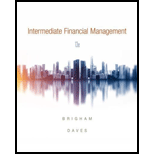
a)
To determine: The definition of interest tax shield and value of tax shield.
a)
Explanation of Solution
The interest tax shield is the amount of cash flow shielded from taxes due to interest tax deductibility. It's the same as
Because MM assume zero growth, the value of the tax shield is T(D). If growth is constant, then the value of the tax shield is
b)
To determine: The definition of adjusted present value (APV) model.
b)
Explanation of Solution
The adjusted present-value model discounts expected free cash flows at rTS's unlevered
c)
To determine: The definition of compressed adjusted present value (CAPV) model.
c)
Explanation of Solution
The condensed modified present-value method discounts expected free cash flows at the unlevered equity cost and also discounted interest tax shields at the unlevered equity cost to determine the value of transactions. It is called the compact APV because there is a discount on the FCF and tax shields at the same price.
d)
To determine: The definition of
d)
Explanation of Solution
This then reduces the FCFEs to hit the price of capital in operations at the leveraged cost of equity. You apply non-operating capital to the value and you get the equity value. You then apply the price of the loan to the value of the transactions. First, the free cash flow for the equity model, or the residual dividend model, measures FCFE, the free cash flow owned by shareholders. FCFE is less interest in cost-free cash flow plus interest tax shield.
Want to see more full solutions like this?
Chapter 17 Solutions
Intermediate Financial Management (MindTap Course List)
- critically discuss the hockey stick model of a start-up financing. In your response, explain the model and discibe its three main stages, highlighting the key characteristics of each stage in terms of growth, risk, and funding expectations.arrow_forwardSolve this problem please .arrow_forwardSolve this finance question.arrow_forward
- solve this question.Pat and Chris have identical interest-bearing bank accounts that pay them $15 interest per year. Pat leaves the $15 in the account each year, while Chris takes the $15 home to a jar and never spends any of it. After five years, who has more money?arrow_forwardWhat is corporate finance? explain all thingsarrow_forwardSolve this finance problem.arrow_forward
 Intermediate Financial Management (MindTap Course...FinanceISBN:9781337395083Author:Eugene F. Brigham, Phillip R. DavesPublisher:Cengage Learning
Intermediate Financial Management (MindTap Course...FinanceISBN:9781337395083Author:Eugene F. Brigham, Phillip R. DavesPublisher:Cengage Learning
 College Accounting, Chapters 1-27AccountingISBN:9781337794756Author:HEINTZ, James A.Publisher:Cengage Learning,
College Accounting, Chapters 1-27AccountingISBN:9781337794756Author:HEINTZ, James A.Publisher:Cengage Learning, Financial Reporting, Financial Statement Analysis...FinanceISBN:9781285190907Author:James M. Wahlen, Stephen P. Baginski, Mark BradshawPublisher:Cengage LearningPrinciples of Accounting Volume 2AccountingISBN:9781947172609Author:OpenStaxPublisher:OpenStax College
Financial Reporting, Financial Statement Analysis...FinanceISBN:9781285190907Author:James M. Wahlen, Stephen P. Baginski, Mark BradshawPublisher:Cengage LearningPrinciples of Accounting Volume 2AccountingISBN:9781947172609Author:OpenStaxPublisher:OpenStax College





